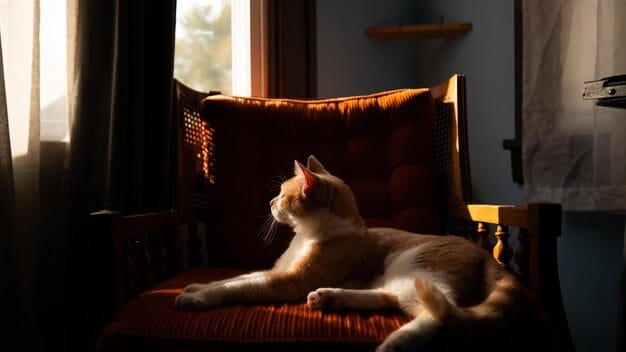Seasonal Affective Disorder in Domesticated Animals: A Deep Dive

Seasonal Affective Disorder in domesticated animals, while not officially recognized as SAD in the same clinical sense as humans, manifests through observable behavioral changes linked to seasonal light cycles, affecting their mood, energy levels, and overall well-being, suggesting a strong correlation with environmental shifts.
As the days grow shorter and the vibrant hues of autumn fade into the muted tones of winter, many individuals notice a distinct shift in their mood and energy levels. But do our beloved pets experience similar seasonal dips? The question of How Does Seasonal Affective Disorder Manifest in Domesticated Animals? is a fascinating one, prompting us to look beyond anecdotal observations and into the science of animal behavior and well-being.
Understanding the Basics: What is SAD in Humans and Animals?
Seasonal Affective Disorder (SAD) in humans is a type of depression linked to seasonal changes, typically worsening in the colder, darker months. It’s often associated with reduced exposure to natural light, which can disrupt the body’s internal clock and affect brain chemistry, particularly serotonin levels and melatonin production. While the term “Seasonal Affective Disorder” is clinically defined for humans, similar physiological and behavioral responses to seasonal shifts can be observed in various animal species, including our domesticated companions. It’s important to differentiate between a clinical diagnosis, which relies on self-reported symptoms, and observable behavioral patterns in animals.
The core concept revolves around the impact of photoperiod—the length of daylight—on an organism’s biological rhythms. As the days shorten, many animals naturally prepare for winter, which can involve changes in metabolism, fur growth, and even migratory patterns for some wild species. In domesticated animals, particularly those heavily integrated into human households, these innate responses might be less pronounced but still present, often manifesting as subtle behavioral alterations that pet owners might notice. Research into these areas is ongoing, aiming to understand the nuances of animal well-being in changing seasons.
The Role of Light and Neurotransmitters
Light plays a crucial role in regulating circadian rhythms and mood. Just as in humans, light influences the production of key neurotransmitters in animals. Reduced light exposure can lead to imbalances:
- Serotonin: Often called the “feel-good” hormone, serotonin levels can dip with decreased light, potentially leading to lower mood and increased irritability.
- Melatonin: This hormone regulates sleep-wake cycles. Longer periods of darkness mean increased melatonin production, which can lead to lethargy and increased desire to sleep.
- Dopamine: Involved in motivation and pleasure, dopamine levels can also be affected by seasonal changes, potentially contributing to reduced enthusiasm for activities.
These neurochemical shifts, while not necessarily indicating clinical depression in the human sense, certainly suggest a biological basis for changes in animal behavior during specific seasons. Understanding these foundational elements is key to recognizing and addressing potential seasonal impacts on our pets.
While the exact mechanisms are complex and specific studies on canine or feline SAD are fewer than those on humans, the biological parallels are compelling. Observing our pets for subtle changes linked to light exposure can offer valuable insights into their internal states and help us provide better care tailored to their seasonal needs.
Observable Behavioral Changes in Dogs
Dogs, being creatures of routine and often highly attuned to their environment, can exhibit a range of behavioral shifts during shorter, darker days. These changes might not be as dramatic as clinical depression in humans, but they are noticeable to an attentive owner. Common manifestations often involve a decrease in energy and enthusiasm for activities they usually enjoy. It’s crucial for owners to observe their dogs closely to distinguish between natural seasonal adjustments and potential signs of discomfort or distress.
One of the most frequently reported signs is a noticeable drop in activity levels. A dog that usually loves long walks and playtime may become more reluctant to go outside, even for short periods. They might spend more time sleeping or appear less engaged during interactions. This lethargy can sometimes be mistaken for simple aging or boredom, but if it consistently aligns with seasonal changes, especially the onset of winter, it warrants closer inspection. This reduced activity can also lead to weight gain if dietary intake isn’t adjusted, creating a compounding issue for the animal’s health.
Appetite and Sleep Pattern Alterations
Seasonal variations can also impact a dog’s appetite and sleep schedule. While some dogs may show a decrease in appetite, others might exhibit an increase, potentially seeking comfort in food. Changes in sleep patterns are also common:
- Increased Sleep: Dogs may sleep more often and for longer durations, seemingly struggling to wake up or showing reduced enthusiasm for their morning routine.
- Changes in Eating Habits: Some dogs might become pickier eaters, while others may seem hungrier, potentially linked to a metabolic slowdown or a compensatory behavior.
- Restlessness at Night: Paradoxically, some dogs might experience disturbed sleep at night, despite being more lethargic during the day, indicating a disruption to their natural circadian rhythm.
These changes are often subtle at first and can easily be dismissed as normal, but a consistent pattern over several weeks or months, recurring annually, is a strong indicator of seasonal influence. It’s also important to rule out any underlying medical conditions by consulting a veterinarian. The well-being of our canine companions during these times really depends on our keen observation and proactive approach to their care.
Seasonal Manifestations in Felines
Cats, despite their often independent nature, are equally susceptible to seasonal shifts that can affect their behavior and mood. While they may not exhibit the same outward enthusiasm or depression as dogs, astute cat owners can often pinpoint changes that align with shorter daylight hours. Their manifestations of seasonal affective disorder, or a similar condition, are often subtler, requiring a close understanding of individual feline personalities and routines. Just like dogs, a decline in baseline activity and changes in social engagement are key indicators.

A common sign in cats is a marked increase in sleep and a decrease in playfulness. A cat that previously enjoyed chasing toys or interacting with its owners might become more sedentary, spending most of its time napping in warm, cozy spots. This can be more pronounced in indoor cats, who have less direct exposure to natural light cycles than outdoor or indoor-outdoor cats. Owners might notice their cat becoming less vocal, less interested in exploring, and generally more withdrawn. These changes, if they align with the darker months, suggest a seasonal influence on their behavior.
Social Changes and Increased Irritability
Beyond lethargy, cats can also display alterations in their social interactions and sometimes an increase in irritability or anxiety:
- Reduced Affection: Some cats may become less affectionate, seeking fewer cuddles or displaying less interest in being petted.
- Increased Hiding: A cat might start hiding more often, seeking solitude rather than spending time with family members.
- Irritability: While not always overtly aggressive, some cats may show increased impatience, hissing, or swatting when disturbed from sleep or relaxation.
- Changes in Grooming: Excessive grooming (over-grooming) or a neglect of grooming can be signs of stress or an overall shift in well-being.
These behavioral shifts can be perplexing for owners, as they may not immediately attribute them to seasonal changes. However, if these patterns recur annually during the colder, darker months, it’s worth considering the impact of reduced light and environmental shifts. Providing a stable and enriching environment, along with potential light therapy, can help mitigate these effects. Cats need their emotional well-being just as much as their physical well-being, and recognizing these subtle cues is paramount to their care.
Other Domesticated Animals: Birds, Hamsters, and More
While much of the focus on domesticated animal behavior tends to be on dogs and cats, other pets, from birds to small mammals, can also be affected by seasonal changes. Their responses are often rooted in their natural instincts and biological clock, which are deeply intertwined with light cycles. Understanding these species-specific manifestations helps pet owners provide tailored care.
Birds, for instance, are highly sensitive to light. Changes in photoperiod often trigger breeding cycles and molting patterns in the wild. In a domesticated setting, a consistent reduction in natural light can disrupt these cycles, potentially leading to behavioral issues. Owners might observe increased aggression, a decrease in singing, or a noticeable change in their bird’s feather condition. Some birds may also become more lethargic, spending more time perched and less time engaging in play or vocalization.
Small Mammals and Hibernation Instincts
Small mammals like hamsters, ferrets, and rodents also show pronounced seasonal changes. Many of these animals possess natural instincts for hibernation or torpor, which are largely triggered by diminishing daylight and dropping temperatures. While domestic pets may not fully hibernate, their bodies still react to these cues:
- Hamsters: Can become less active, hoard more food, and sleep for longer periods. Their metabolism might slow down, mimicking a partial “hibernation mode.”
- Ferrets: Often experience a seasonal weight gain, increased sleep, and may even “coat blow” (shedding their old coat for a thicker winter one). Their energy levels tend to drop significantly.
- Rabbits: Can also show signs of increased lethargy and reduced interest in foraging or play, particularly if their enclosure lacks sufficient natural light or temperature regulation.
Observing these changes is vital. For most of these animals, it’s about providing a consistent environment that minimizes drastic seasonal shifts. This might involve supplementary lighting, consistent temperatures, and adjusting their diet to accommodate changes in activity. Being proactive in managing their environment can help prevent discomfort and maintain their overall health and happiness throughout the year.
Mitigation Strategies and Supportive Care
Once an owner suspects their pet might be experiencing seasonal affective changes, the next crucial step is to implement strategies to mitigate these effects and provide supportive care. The goal is to counteract the negative impacts of reduced light and environmental shifts, promoting a stable and enriching environment for the animal. While professional veterinary advice is always recommended, many interventions can be effectively implemented at home.
One of the most effective strategies involves increasing exposure to natural or artificial light. For pets, this can mean ensuring they have access to sunny spots in the house or increasing the amount of time they spend outdoors during daylight hours. However, simply being near a window might not be enough. Specialized light therapy lamps, similar to those used for humans with SAD, can also be beneficial:
Light Therapy and Environmental Enrichment
- Full-Spectrum Lighting: Using full-spectrum bulbs in the pet’s living area can mimic natural sunlight, helping to regulate their circadian rhythms. Ensure the light source is positioned safely and doesn’t cause discomfort.
- Timed Exposure: Gradually increasing light exposure in the mornings and evenings can help adjust their internal clock, especially for nocturnal animals or those with disrupted sleep patterns.
- Outdoor Time: Maximize outdoor activity during daylight hours, even if it’s just a short walk or supervised yard time. This also provides essential exercise and mental stimulation.
- Enrichment: Combat lethargy and boredom with increased mental and physical enrichment. New toys, puzzle feeders, interactive games, and training sessions can keep pets engaged and stimulated, regardless of the season.
Beyond light, ensuring a comfortable and consistent environment is equally important. This includes maintaining steady indoor temperatures, providing cozy resting spots, and sticking to a regular feeding and exercise schedule. Consistency in routines offers a sense of security and predictability, which can be particularly calming for animals sensitive to seasonal changes.
Dietary adjustments might also be considered. Some pets may benefit from supplements, such as omega-3 fatty acids, which have mood-stabilizing properties, or specific vitamins, especially Vitamin D if their exposure to sunlight is drastically reduced. Always consult with a veterinarian before making significant changes to your pet’s diet or introducing new supplements. Holistic care, encompassing physical comfort, mental stimulation, and emotional support, is key to helping our pets thrive year-round.
The Scientific Perspective and Research Gaps
While the concept of seasonal affective disorder in domesticated animals is gaining traction among pet owners and some veterinarians, it’s important to approach it from a scientific perspective. Much of the evidence linking seasonal changes to behavioral shifts in pets is anecdotal or based on observations rather than extensive clinical trials that meet the rigorous standards applied to human medical conditions. The term “Seasonal Affective Disorder” itself is a human diagnostic label, and applying it directly to animals requires careful consideration of species-specific physiology and psychology.
Research into this area is challenging because animals cannot verbally communicate their internal states. Instead, scientists rely on observable behaviors, physiological markers (like hormone levels), and responses to interventions (such as light therapy) to infer a condition similar to SAD. Studies often focus on specific physiological changes, such as melatonin and serotonin fluctuations in response to photoperiod changes, which provide a biological basis for observed behavioral changes. However, directly linking these to a “disorder” in a clinical sense remains an area with significant research gaps.
Future Directions in Animal Behavior Research
The scientific community acknowledges the strong evidence for photoperiodism affecting animal behavior, mood, and physiology across many species. Future research aims to bridge these gaps and provide clearer insights:
- Standardized Behavioral Assessments: Developing standardized scales and tools to objectively measure changes in animal behavior and mood across different seasons.
- Biomarker Identification: Identifying specific biomarkers in blood, urine, or saliva that correlate with seasonal behavioral changes and could serve as diagnostic indicators.
- Controlled Studies: Conducting more controlled studies with larger sample sizes, comparing groups of animals exposed to different light regimens and environmental conditions.
- Genetic Predisposition: Investigating if certain breeds or individual animals have a genetic predisposition to seasonal mood shifts, similar to variations observed in humans.
As our understanding of animal cognition and emotion evolves, so too will our ability to accurately assess and address conditions like seasonal affective changes. By combining careful observation with robust scientific methodologies, we can move closer to providing evidence-based care that enhances the well-being of our domesticated companions year-round. This ongoing exploration helps us appreciate the intricate connection between environment and internal experience in the animal kingdom, influencing how we care for our cherished pets.
When to Seek Veterinary Advice
Recognizing potential seasonal affective changes in your pet is the first step, but knowing when to consult a veterinarian is equally crucial. While many seasonal shifts are minor and can be managed with home interventions, some changes might indicate a more serious underlying health issue that requires professional attention. A veterinarian can rule out other medical conditions and provide tailored advice, ensuring your pet receives the most appropriate care.
It’s important to remember that many symptoms associated with seasonal shifts—such as lethargy, changes in appetite, or irritability—can also be signs of various illnesses or chronic pain. Therefore, a sudden or severe change in your pet’s behavior, regardless of the season, should always prompt a veterinary visit. Early diagnosis and treatment are often key to successful outcomes for many health problems. Delaying care can lead to worsening conditions and increased discomfort for your pet.
Key Indicators for Veterinary Consultation
There are specific signs that strongly suggest it’s time to seek professional veterinary help. These include:
- Sudden or Drastic Behavioral Change: Any sharp or unusual shift in behavior that lasts for more than a few days, such as extreme aggression, sudden loss of appetite for multiple meals, or severe lameness.
- Persistent Lethargy: If your pet’s lack of energy is severe, prevents them from engaging in daily activities, or if they seem unusually weak.
- Changes in Elimination Habits: Incontinence, frequent accidents, or straining to urinate or defecate can indicate urinary tract infections, kidney issues, or other gastrointestinal problems.
- Weight Fluctuations: Unexplained weight loss or gain, especially if accompanied by other symptoms, warrants investigation.
- Vocalization Changes: Increased whining, howling, or meowing, particularly if it seems indicative of pain or distress.
- Visible Physical Symptoms: Vomiting, diarrhea, coughing, sneezing, limping, or any other clear physical sign of illness.
Even if you suspect seasonal influences, a veterinary check-up provides peace of mind and ensures that you’re not overlooking a critical health concern. Your vet can offer guidance on light therapy, dietary supplements, and environmental adjustments, potentially even distinguishing between behavioral and medical origins of the changes you observe. They are your best resource for maintaining your pet’s long-term health and well-being, helping them navigate seasonal changes with comfort and vitality.
| Key Aspect | Brief Description |
|---|---|
| ☀️ Light Influence | Reduced daylight affects animal mood, energy, and biological rhythms. |
| 🐾 Dog Behaviors | Lethargy, decreased enthusiasm for walks, altered sleep/appetite. |
| 🐈 Cat Behaviors | Increased sleep, reduced playfulness, less affection, occasional irritability. |
| 💡 Mitigation | Light therapy, increased outdoor time, environmental enrichment, stable routines. |
Frequently Asked Questions About Seasonal Affective Disorder in Pets
While veterinarians acknowledge and treat behavioral changes linked to seasonal shifts, they don’t typically use the exact clinical diagnosis “Seasonal Affective Disorder” for pets. The term SAD is specific to human psychiatric criteria. Instead, they identify and address observable symptoms and behavioral patterns influenced by changes in light and environment, offering supportive care and ruling out other medical conditions.
The main cause is reduced exposure to natural light during shorter days, particularly in autumn and winter. This lack of light can disrupt an animal’s circadian rhythm and affect brain chemistry, including levels of serotonin (mood regulator) and melatonin (sleep regulator). Temperature changes, decreased outdoor activity, and altered routines can also contribute to these seasonal behavioral shifts in pets.
Pets with a strong natural photoperiodic response, like some northern dog breeds (e.g., Siberian Huskies, Malamutes) or breeds with dense fur adapted for colder climates, might be more visibly affected. Indoor pets, especially those with limited access to natural light, might also show more pronounced changes. However, any domesticated animal can potentially experience some level of seasonal behavioral shifts, regardless of breed.
The response to light therapy can vary. Some owners report improvements within a few weeks of consistent use, while for others, it might take longer. Consistency is key. It’s often recommended to start light therapy before the shortest days of winter begin, as a preventative measure. Always consult your veterinarian for specific guidance on light therapy duration and intensity for your pet’s needs.
Seasonal changes present symptoms that consistently recur with specific seasons, typically the darker months, and often resolve themselves when daylight lengthens. Boredom might be resolved with new toys or activities, while illness typically presents with more acute physical symptoms (e.g., vomiting, pain) and doesn’t follow a seasonal pattern. If unsure, a veterinary check-up is always recommended to rule out underlying health issues.
Conclusion
The intricate connection between light cycles and the behavior of domesticated animals is undeniable, even if the precise clinical nomenclature mirrors that of humans. While we may not formally diagnose our pets with “Seasonal Affective Disorder,” the evidence suggests that many experience discernible seasonal shifts in mood, energy, and overall well-being. From the lethargy of a normally spirited dog to a cat’s increased desire for solitude, these changes underscore the profound influence of their environment.
As responsible pet owners, our role extends beyond providing food and shelter; it encompasses understanding and responding to their subtle cues. By recognizing how changes in light affect their physiology and implementing supportive strategies—such as increased natural light exposure, light therapy, consistent routines, and enriched environments—we can help mitigate the impact of darker months. This proactive approach not only enhances their quality of life but also strengthens the bond we share, ensuring our beloved companions thrive year-round, regardless of the season.





